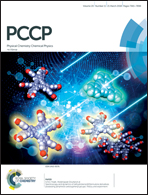The kinetics and mechanism of oxidation of reduced phosphovanadomolybdates by molecular oxygen: theory and experiment in concert †‡
Abstract
The reactivity of the H5PV2Mo10O40 polyoxometalate and its analogues as an electron transfer and electron transfer–oxygen transfer oxidant has been extensively studied in the past and has been shown to be useful in many transformations. One of the hallmarks of this oxidant is the possibility of its re-oxidation with molecular oxygen, thus enabling aerobic catalytic cycles. Although the re-oxidation reaction was known, the kinetics and mechanism of this reaction have not been studied in any detail. Experimentally, we show that both the one- and two-electron reduced polyoxometalate are reactive with O2, the two-electron one more so. The reactions are first-order in the polyoxometalate and O2. Solvents also have a considerable effect, protic solvents being preferred over aprotic ones. H5PV2Mo10O40 was reduced either by an electron transfer reaction (H2) or an electron transfer–oxygen transfer reaction (Ph3P). Similar rate constants and activation parameters were observed for both. DFT calculations carried out on the re-oxidation reactions strongly suggest an inner-sphere process. The process involves first the formation of a coordinatively unsaturated site (CUS) and subsequently the binding of O2 to form superoxo and then peroxo η2-O2 adducts. Most interestingly, although vanadium is the reactive redox centre as well as a necessary component for the oxidative activity of H5PV2Mo10O40, and a CUS can be formed at both Mo and V sites, O2 coordination occurs mostly at the Mo CUSs, preferably those where the vanadium centers are distal to each other.



 Please wait while we load your content...
Please wait while we load your content...